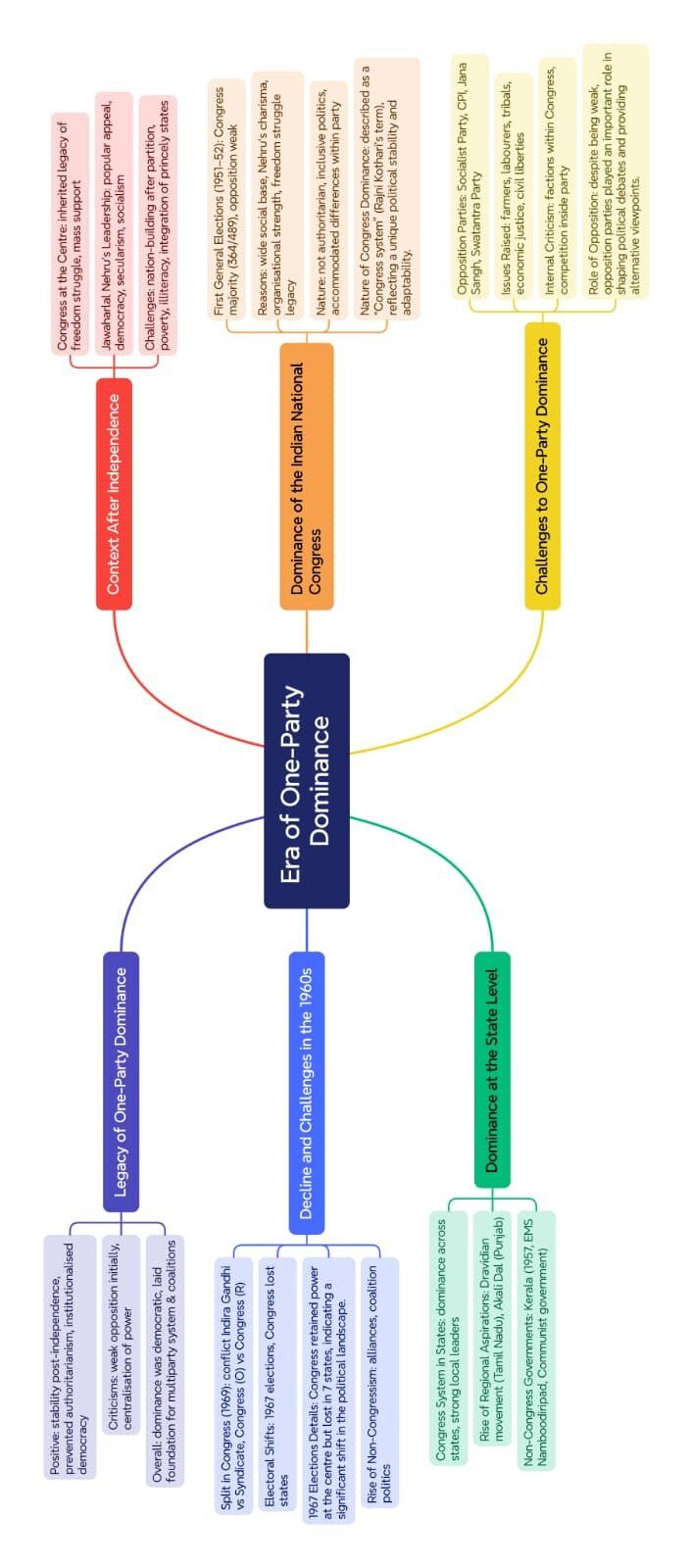Class 12 : Poltical Science (English) – Lesson 9.Era of One-Party Dominance
EXPLANATION & SUMMARY
Introduction to the Era of One-Party Dominance
🔵 Background Context:
The period immediately after independence in India was marked by the clear and widespread dominance of the Indian National Congress (INC) in the political sphere. The Congress had been at the forefront of the national movement for independence, and this historical legacy earned it widespread trust and popularity among the Indian masses.
🟢 First General Elections (1952):
➡️ India conducted its first general elections in 1951-52 under the framework of universal adult franchise. This was a bold experiment in democracy, as India was still a newly independent, diverse, and largely illiterate country.
✔️ Congress emerged victorious with a clear majority at both the centre and in most states.
✔️ Jawaharlal Nehru became the first elected Prime Minister of independent India.
✏️ Note: These elections laid the foundation of India’s democratic credentials globally.
Why Congress Dominated
Historical Legacy of Congress
🔴 The Congress had led the anti-colonial struggle, which gave it legitimacy and deep-rooted organisational strength.
🔴 It was perceived not merely as a political party but as the representative of the aspirations of a newly independent nation.
🌿 Broad Social Representation:
✔️ Congress included within its fold people of all communities, castes, regions, and economic backgrounds.
✔️ It functioned as a large umbrella organisation accommodating various interests.
⚡ Leadership Factor:
Jawaharlal Nehru’s leadership also contributed immensely to this dominance. His vision of socialism, secularism, and democracy appealed to a large section of Indian society.
💡 Concept: The Congress was a movement-based party transitioning into a political party in government.
Nature of Congress Dominance
Democratic Nature of Its Rule
🟡 Though the Congress enjoyed dominance, India did not become a one-party state like China or the USSR.
✔️ Free and fair elections were held regularly.
✔️ Opposition parties existed but lacked organisational strength.
➡️ Internal Factions within Congress
✔️ Congress itself had many internal factions, reflecting diverse ideologies and interests.
✔️ These factions often competed with each other, ensuring that different voices found representation within the system.
✏️ Note: The dominance of Congress was electoral, not authoritarian.
Electoral Successes of Congress
First Three General Elections (1952, 1957, 1962)
🟢 Congress won these elections with a comfortable majority.
✔️ These victories showed the party’s widespread appeal.
✔️ Nehru’s popularity and Congress’s organisational network played a major role.
🔵 Policies and Programmes
✔️ The Congress advocated policies of planned economic development, secularism, and welfare of the poor.
✔️ These policies aligned with the aspirations of a newly independent nation.
🌿 Example of Political Continuity
✔️ Despite different challenges like linguistic reorganisation of states and integration of princely states, Congress maintained political stability.
Opposition to Congress
Existence of Opposition Parties
🔴 Though Congress dominated, several opposition parties actively participated in the democratic process.
✔️ They often raised important issues and provided alternative perspectives.
🟡 Key Opposition Parties
Socialist Parties: Criticised Congress’s approach towards socialism as insufficiently radical.
Communist Parties: Strong in pockets like Kerala and West Bengal, these parties championed workers’ and peasants’ rights.
Bharatiya Jana Sangh: Advocated Hindu nationalist ideas.
Swatantra Party: Favoured market economy and was critical of Congress’s socialist leanings.
➡️ Role of Opposition:
✔️ They strengthened the democratic process even if they could not challenge Congress’s dominance immediately.
Nature of Congress’ Internal Functioning
Factions within the Party
🟢 Congress was often described as a “coalition of interests” rather than a monolithic party.
✔️ Internal groups represented various ideological and regional aspirations.
✔️ These factions competed for power and influence within the party.
⚡ Leadership Mediation
Nehru played a balancing role, preventing any one faction from becoming overly dominant. This maintained the party’s unity.
✏️ Note: Internal competition ensured that Congress functioned like a system accommodating opposition within itself.
Challenges to Congress Dominance
From Within and Outside
🔴 Even during this period, there were signs of resistance and discontent.
✔️ Internal conflicts sometimes led to splits and re-alignments.
✔️ Regional parties began gaining strength in states like Tamil Nadu and Kerala.
🌿 Kerala Experiment
✔️ In 1957, Kerala elected the first communist government in the world through democratic elections, led by EMS Namboodiripad.
✔️ This was a significant moment as it demonstrated the strength of democracy in India.
💡 Concept: Democracy allows space for alternative ideologies and voices, even during dominant phases.
Dominance Without Hegemony
🟡 Though dominant, Congress did not suppress dissent through force.
✔️ Its dominance was due to popular support, not coercion.
✔️ Electoral politics remained open and competitive.
➡️ Respect for Opposition
✔️ Congress governments allowed peaceful transfers of power in states where opposition parties won.
✔️ Examples: Kerala (1957), Orissa, and Madras (later Tamil Nadu).
Nehru’s Vision and Impact
Nehru’s Role in Shaping Post-Independence India
🔵 Nehru’s leadership left a lasting imprint on India’s democracy and political culture.
✔️ Advocated secularism, socialism, scientific temper, and non-alignment in foreign policy.
✔️ Focused on building institutions like Planning Commission, IITs, and CSIR.
🟢 Legacy of Democratic Values
✔️ Nehru resisted pressures to suppress opposition, respecting electoral verdicts.
✔️ Supported linguistic reorganisation despite initial reluctance, respecting democratic demands.
✏️ Note: Nehru shaped both Congress and Indian democracy during this phase.
Consequences of Congress Dominance
Positive Outcomes
🌿 Political stability in a diverse and newly independent nation.
🌿 Institutionalisation of democracy through regular elections.
🌿 Establishment of developmental priorities.
Limitations
🔴 Over-centralisation of power.
🔴 Rise of internal factionalism.
🔴 Neglect of grassroots leadership.
Transition Towards Multiparty System
End of the Era (Post-1967)
⚡ The dominance of Congress began to decline after the 1967 elections.
✔️ Several states saw non-Congress governments coming to power.
✔️ Rise of regional parties and coalitions marked a shift.
🟡 Importance of 1967 Elections
✔️ Marked the end of Congress’s unchallenged dominance.
✔️ Highlighted the maturity of India’s democracy.
💡 Concept: India moved from one-party dominance to a more competitive multiparty system.
Real-Life Connection 🌍
Even today, the debates around dominant parties versus coalition politics continue. Understanding this era helps explain how India’s democracy evolved and why it values electoral competition so highly.
Why This Lesson Matters 🧠
➡️ Helps understand the foundations of India’s democracy.
➡️ Explains how institutions, not individuals, sustain democratic systems.
➡️ Highlights the role of electoral politics in integrating a diverse nation.
📝 Quick Recap:
🔵 First three elections — Congress dominance.
🟢 Nehru’s leadership critical to stability.
🔴 Opposition existed but weak.
🟡 Congress functioned through internal factions.
🌿 Kerala 1957 — first Communist government through democracy.
⚡ 1967 — beginning of decline in dominance.
300-Word Summary (Revision-Friendly)
🔵 The Era of One-Party Dominance refers to the period after India’s independence when the Congress Party dominated national politics. This dominance lasted from 1952 to 1967 and was marked by repeated electoral victories in the first three general elections.
🟢 Why Congress Dominated: Congress had a historical legacy of leading the freedom struggle, enjoyed mass support, and included within itself diverse social, regional, and ideological factions. Nehru’s leadership also contributed significantly to this dominance through his vision of democracy, secularism, and development.
🔴 Nature of Dominance: India remained a democracy; free and fair elections were held, and opposition parties existed. Congress’s dominance was electoral, not authoritarian. Within Congress, factions acted as internal checks, making the party function almost like a system with internal opposition.
🟡 Opposition Parties: Although weak at the centre, opposition parties like the Socialists, Communists, Bharatiya Jana Sangh, and Swatantra Party raised important issues and participated actively in elections. In Kerala (1957), the Communist Party formed the world’s first democratically elected communist government.
🌿 Challenges and Decline: Internal factionalism, regional aspirations, and the rise of opposition parties led to the decline of Congress dominance after the 1967 elections. India’s democracy matured, moving towards a competitive multiparty system.
💡 Importance: This phase established the foundation of India’s electoral democracy, demonstrated the strength of democratic institutions, and showed the capacity of the system to accommodate diverse voices without resorting to authoritarianism.
➡️ Legacy: The era left behind a stable democratic structure, respected electoral processes, and reinforced the idea that in India, political dominance cannot be permanent without popular support.
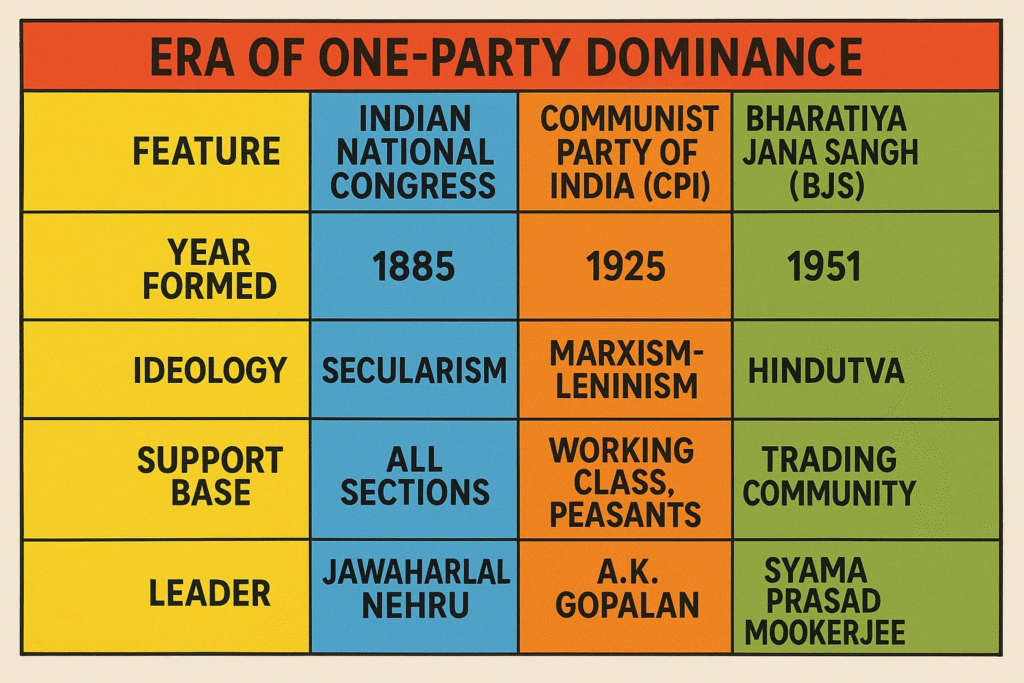
—————————————————————————————————————————————————————————————————————————————–
QUESTIONS FROM TEXTBOOK
QUESTION 1
Choose the correct option to fill in the blanks.
(a) The First General Elections in 1952 involved simultaneous elections to the Lok Sabha and …………….
(The President of India / State Assemblies / Rajya Sabha / The Prime Minister)
ANSWER 1
➡️ Correct Answer: State Assemblies
🔵 In the first general elections of 1952, both the Lok Sabha and the State Assemblies were elected simultaneously.
QUESTION 1 (b)
The party that won the second largest number of Lok Sabha seats in the first elections was the …………….
(Praja Socialist Party / Bharatiya Jana Sangh / Communist Party of India / Bharatiya Janata Party)
ANSWER 1 (b)
➡️ Correct Answer: Communist Party of India
🟢 The Communist Party of India secured the second-largest number of seats in the first Lok Sabha elections.
QUESTION 1 (c)
One of the guiding principles of the ideology of the Swatantra Party was …………….
(Working class interests / protection of Princely States / economy free from State control / Autonomy of States within the Union)
ANSWER 1 (c)
➡️ Correct Answer: economy free from State control
🟡 The Swatantra Party opposed excessive state control and favoured a free economy.
QUESTION 2
Match the following leaders listed in List A with the parties in List B.
🔷 List A
(a) S. A. Dange
(b) Shyama Prasad Mukherjee
(c) Minoo Masani
(d) Asoka Mehta
🔷 List B
i. Bharatiya Jana Sangh
ii. Swatantra Party
iii. Praja Socialist Party
iv. Communist Party of India
ANSWER 2
➡️ Correct Matches:
🔴 (a) S. A. Dange ➡️ iv. Communist Party of India
🟢 (b) Shyama Prasad Mukherjee ➡️ i. Bharatiya Jana Sangh
🟡 (c) Minoo Masani ➡️ ii. Swatantra Party
🔵 (d) Asoka Mehta ➡️ iii. Praja Socialist Party
QUESTION 3
Four statements regarding one-party dominance are given below. Mark each of them as true or false.
(a) One-party dominance is rooted in the absence of strong alternative political parties.
ANSWER 3 (a)
✔️ True
🔷 The dominance of Congress was largely due to the weakness of opposition parties during this period.
QUESTION 3 (b)
One-party dominance occurs because of weak public opinion.
ANSWER 3 (b)
❌ False
🟢 Congress enjoyed dominance not because of weak public opinion but because of its popularity and historical legacy.
QUESTION 3 (c)
One-party dominance is linked to the nation’s colonial past.
ANSWER 3 (c)
✔️ True
🔴 Congress had roots in the freedom struggle and continued its dominance post-independence, linked to its role during the colonial era.
QUESTION 3 (d)
One-party dominance reflects the absence of democratic ideals in a country.
ANSWER 3 (d)
❌ False
🟡 India had democratic elections even during Congress dominance. Therefore, one-party dominance here did not mean the absence of democracy.
QUESTION 4
Take a political map of India (with State outlines) and mark:
(a) Two states where Congress was not in power at some point during 1952-67.
ANSWER 4 (a)
✔️ States: Kerala and Orissa
🔵 Kerala elected a Communist government in 1957.
🟢 Orissa also witnessed non-Congress governments during this period.
QUESTION 4 (b)
Two states where the Congress remained in power through this period.
ANSWER 4 (b)
✔️ States: Maharashtra and Gujarat
🔴 Congress retained continuous power in Maharashtra and Gujarat between 1952–1967.
QUESTION 5
Read the following passage and answer the questions below:
“Patel, the organisational man of the Congress, wanted to purge the Congress of other political groups and sought to make of it a cohesive and disciplined political party. He … sought to take the Congress away from its all-embracing character and turn it into a close-knit party of disciplined cadres. Being a ‘realist’ he looked more for discipline than for comprehension. While Gandhi took too romantic a view of ‘carrying on the movement’, Patel’s idea of transforming the Congress into strictly political party with a single ideology and tight discipline showed an equal lack of understanding of the eclectic role that the Congress, as a government, was to be called upon to perform in the decades to follow.” — Rajni Kothari
(a) Why does the author think that Congress should not have been a cohesive and disciplined party?
ANSWER 5 (a)
➡️ The author believes that Congress, in the early years, played an eclectic and inclusive role representing various social groups, regions, and ideologies. Turning it into a rigid, disciplined party would have reduced its flexibility and weakened its ability to accommodate diverse interests in a large and diverse country like India.
QUESTION 5 (b)
Give some examples of the eclectic role of the Congress party in the early years.
ANSWER 5 (b)
🔷 Congress represented a broad spectrum of society:
🟢 Industrialists and labourers
🟡 Peasants and landlords
🔵 Right-wing and left-wing groups
🔴 Religious communities and secular groups
➡️ This eclectic nature allowed Congress to act as a platform for national unity.
QUESTION 5 (c)
Why does the author say that Gandhi’s view about Congress’s future was romantic?
ANSWER 5 (c)
✔️ Gandhi’s vision of Congress was as a movement for social reform and moral upliftment, not just a political party focused on elections and governance.
🟢 He believed in continuing mass mobilisation, which was more idealistic and less practical for post-independence politics.
➡️ The author calls this romantic because it was not suited for the realities of governing a complex, modern nation-state.
————————————————————————————————————————————————————————————————————————————
OTHER IMPORTANT QUESTIONS FOR EXAMS
(CBSE MODEL QUESTIONS PAPER)
ESPECIALLY MADE FROM THIS LESSON ONLY
Q1. Which year did the first general elections take place in independent India?
(A) 1947
(B) 1950
(C) 1951-52
(D) 1956
Answer: (C) 1951-52
Q2. Who was the first Prime Minister elected after India’s first general elections?
(A) Dr. Rajendra Prasad
(B) Jawaharlal Nehru
(C) Sardar Patel
(D) C. Rajagopalachari
Answer: (B) Jawaharlal Nehru
Q3. Which party won the majority in the first general elections?
(A) Communist Party of India
(B) Socialist Party
(C) Indian National Congress
(D) Swatantra Party
Answer: (C) Indian National Congress
Q4. Which state elected the world’s first democratically elected communist government in 1957?
(A) West Bengal
(B) Kerala
(C) Tamil Nadu
(D) Andhra Pradesh
Answer: (B) Kerala
Q5. Which party advocated for free-market policies in opposition to Congress’s socialism?
(A) Bharatiya Jana Sangh
(B) Communist Party of India
(C) Swatantra Party
(D) Socialist Party
Answer: (C) Swatantra Party
Q6. Assertion (A): Congress dominance between 1952-1967 was total and authoritarian.
Reason (R): India held free and fair elections during this period.
Options:
(A) Both A and R are true, and R is the correct explanation of A.
(B) Both A and R are true, but R is not the correct explanation of A.
(C) A is true, but R is false.
(D) A is false, but R is true.
Answer: (D) A is false, but R is true.
Q7. Which political party had close ties with Hindu nationalist ideology during this period?
(A) Swatantra Party
(B) Communist Party of India
(C) Bharatiya Jana Sangh
(D) Congress Socialist Party
Answer: (C) Bharatiya Jana Sangh
Q8. Who among the following was associated with the foundation of the Bharatiya Jana Sangh?
(A) Sardar Patel
(B) Minoo Masani
(C) Shyama Prasad Mukherjee
(D) Asoka Mehta
Answer: (C) Shyama Prasad Mukherjee
Q9. Congress maintained power consistently in which of the following states during 1952-67?
(A) Gujarat
(B) Kerala
(C) Tamil Nadu
(D) Orissa
Answer: (A) Gujarat
Q10. The Swatantra Party was founded in reaction to:
(A) Congress’s embrace of socialism
(B) Congress’s embrace of communalism
(C) Communist movement in India
(D) Congress’s embrace of democracy
Answer: (A) Congress’s embrace of socialism
Q11. Very short answer: What do you understand by ‘Congress system’?
Answer:
‘Congress system’ refers to the dominance of Congress in Indian politics, where it acted like an umbrella accommodating multiple groups, functioning almost like a system with opposition within itself.
Q12. Very short answer: Name one prominent opposition party active during this period.
Answer:
Communist Party of India (CPI)
Q13. Very short answer: Name any one leader of the Swatantra Party.
Answer:
Minoo Masani
Q14. Very short answer: Why was Kerala’s 1957 election significant?
Answer:
It led to the formation of the world’s first democratically elected communist government.
Q15. Very short answer: What is meant by ‘factionalism’ within Congress?
Answer:
Factionalism refers to the internal competition among different groups within the Congress party.
Q16. Very short answer: Who called Congress dominance a ‘Congress system’?
Answer:
Political scientist Rajni Kothari.
Q17. Very short answer: Mention any one principle advocated by the Bharatiya Jana Sangh.
Answer:
Promotion of Hindu cultural nationalism.
Q18. Very short answer: State one reason for Congress’s electoral dominance in the early years.
Answer:
Its historical role in the freedom movement gave it widespread legitimacy.
Q19. Why did Congress remain the dominant political force in India during the early years of independence?
Answer:
🔵 Congress had deep roots in the freedom struggle, making it highly popular and trusted.
🟢 It had a strong organisational structure that reached rural areas.
🟡 Congress acted as an umbrella party, accommodating diverse interests like farmers, workers, businesspeople, and different castes and communities.
➡️ This inclusivity made it difficult for any opposition party to challenge it effectively.
Q20. Write any two features of the first general elections of 1952.
Answer:
🔵 It was the largest democratic exercise in the world at the time, with over 173 million people eligible to vote.
🟢 Simultaneous elections were held for both the Lok Sabha and State Assemblies.
🟡 Voting was conducted through secret ballot and universal adult franchise.
➡️ Congress won with a clear majority.
Q21. How did internal factions within the Congress help maintain its dominance?
Answer:
🟢 Congress was not monolithic; it allowed multiple ideological groups within itself.
🔵 These internal factions often acted as checks and balances on one another.
🟡 This diversity within helped absorb dissent, preventing splintering and maintaining unity.
Q22. What was the significance of the Communist Party forming a government in Kerala in 1957?
Answer:
🔵 It was the world’s first democratically elected communist government.
🟢 This event showed that Indian democracy allowed space for ideological diversity.
🟡 It reinforced the credibility of India’s democratic system.
Q23. Why did regional parties start gaining strength after the dominance of Congress?
Answer:
🟢 Congress’s inability to address specific regional issues gave rise to regional aspirations.
🔵 Regional parties focused on linguistic, cultural, and local development demands.
🟡 These parties provided platforms for regional identities that Congress often overlooked.
Q24. Explain the three main reasons why Congress dominance in the first three general elections is considered democratic.
Answer:
🔵 Free and Fair Elections: Regular elections were held, monitored by the Election Commission.
🟢 Presence of Opposition: Though weak, opposition parties participated and won seats.
🟡 Voter Choice: Voters freely chose Congress over others, indicating popular support and trust.
Q25. Discuss the ideological position of the Swatantra Party and its criticism of Congress.
Answer:
🔵 The Swatantra Party opposed Congress’s tilt towards socialism and state control of the economy.
🟢 It advocated for free-market policies and individual freedoms.
🟡 The party criticised Congress for centralising power and neglecting rural elites and business interests.
Q26. What role did Nehru’s leadership play in maintaining Congress dominance?
Answer:
🔵 Nehru’s personal charisma and popularity attracted a wide base of support.
🟢 His policies of secularism, socialism, and non-alignment resonated with the public.
🟡 He balanced various factions within Congress, ensuring stability and unity.
Q27. Explain any three consequences of Congress’s dominance for India’s democracy.
Answer:
🔵 Political Stability: Provided stability in the formative years of democracy.
🟢 Institution Building: Helped establish democratic institutions and governance structures.
🟡 Delayed Rise of Opposition: Delayed the emergence of a strong opposition, leading to eventual dissatisfaction and growth of alternatives post-1967.
Q28. Differentiate between the Congress dominance of 1952-67 and one-party rule in non-democratic countries.
Answer:
🔵 India’s Congress: Won free, fair elections; allowed opposition and dissent; respected civil liberties.
🟢 Non-democratic Countries: Often used force or suppression to maintain dominance; lacked fair elections.
🟡 India: Congress’s dominance was based on popularity, not coercion.
Q29. Read the following passage and answer the questions that follow:
“Congress in the early years after independence was a broad platform accommodating all shades of opinion. This allowed the party to appear as a national representative, but also made it vulnerable to factionalism. This characteristic of Congress enabled it to dominate Indian politics while adapting to changing circumstances.”
(i) Why was Congress considered a broad platform? (1)
(ii) What was the advantage of accommodating various shades of opinion? (1)
(iii) How did internal factions help Congress stay relevant? (2)
ANSWER 29:
(i) Congress included members from diverse ideological, social, and regional backgrounds.
(ii) It allowed Congress to claim representation of all Indians and maintain widespread appeal.
(iii) Internal factions allowed debates within the party, acting like an internal opposition, keeping Congress flexible and adaptable to change.
Q30. Read the following case and answer the questions below:
“Despite the Congress dominance at the national level, states like Kerala and Orissa witnessed non-Congress governments. Kerala, in particular, became significant by electing the world’s first democratically elected communist government in 1957.”
(i) Name the leader of the Communist government in Kerala in 1957. (1)
(ii) What does this signify about Indian democracy? (1)
(iii) How did Congress respond to such challenges at the state level? (2)
ANSWER 30:
(i) EMS Namboodiripad
(ii) It showed India’s democracy allowed ideological diversity and free choice.
(iii) Congress often respected democratic outcomes but also sometimes used constitutional means, like President’s Rule, to regain control in such states.
Q31. Read the passage and answer the questions:
“The dominance of Congress was not a result of suppression but because of its popularity, organisational strength, and historical legacy. However, by the late 1960s, this dominance began to face challenges.”
(i) Mention one reason for Congress’s early popularity. (1)
(ii) How did Congress maintain organisational strength? (1)
(iii) State two reasons why its dominance began to decline after 1967. (2)
ANSWER 31:
(i) Congress had led the freedom movement and earned people’s trust.
(ii) Congress had a nationwide network from village to national level.
(iii) Rise of strong regional parties and internal factionalism weakened Congress’s dominance.
Q32. Describe the role of Congress in laying the foundation of India’s democracy during 1952-1967.
ANSWER 32:
🔵 Free and Fair Elections: Congress ensured regular elections under a neutral Election Commission.
🟢 Respect for Opposition: Allowed opposition parties to function, strengthening democracy.
🟡 Institution Building: Established institutions like the Planning Commission, IITs, and reinforced the judiciary’s independence.
🔴 Federal Structure: Managed demands like linguistic reorganisation peacefully, reinforcing unity in diversity.
➡️ Congress’s dominance was based on public support, not suppression, laying a democratic tradition for future governments.
Q33. Evaluate the impact of the 1967 elections on Congress’s dominance and Indian politics.
ANSWER 33:
🔵 End of Unchallenged Dominance: Congress lost power in several states, showing people’s willingness to vote for change.
🟢 Rise of Coalition Politics: Non-Congress coalitions emerged in states like Punjab and West Bengal.
🟡 Growth of Regional Parties: States like Tamil Nadu saw the rise of strong regional parties (e.g., DMK).
🔴 Political Maturity: Indian democracy matured as competitive politics gained space.
➡️ The 1967 elections marked a shift towards a multiparty system.
Q34. Compare the Congress dominance period with one-party systems of non-democratic countries.
ANSWER 34:
🔵 Democratic Features in India:
Free elections
Respect for opposition
Civil liberties protected
🟢 Non-Democratic One-Party States:
Elections are manipulated or absent
Opposition suppressed violently
Media controlled, dissent crushed
🟡 India’s Congress: Dominance came from public trust, not coercion.
🔴 Conclusion: Congress dominance reflected people’s choice, unlike forced one-party rule.
Q35. Analyse how the internal diversity of Congress contributed to its political dominance.
ANSWER 35:
🔵 Umbrella Organisation: Included leftists, centrists, conservatives, business groups, farmers, workers.
🟢 Internal Checks: Different factions prevented extremism and allowed multiple viewpoints.
🟡 Flexible Policies: Could adjust policies based on internal debates, staying relevant.
🔴 Leadership Balance: Leaders like Nehru maintained harmony among factions.
➡️ This inclusiveness helped Congress maintain its wide support base and adapt to changing political landscapes.
————————————————————————————————————————————————————————————————————————————
QUESTIONS FROM COMPETITION EXAMS
🔵 Q1. In the first Lok Sabha elections, Congress secured how many seats?
(A) 252
(B) 364
(C) 401
(D) 489
✅ Answer: (B) 364
📅 Exam: UPSC Prelims 2016
📝 Explanation: Congress won 364/489 seats in 1952.
━━━━━━━━━━━━━━━
🔵 Q2. The first General Election was held in:
(A) 1947
(B) 1950
(C) 1951-52
(D) 1955
✅ Answer: (C) 1951-52
📅 Exam: SSC CHSL 2014
📝 Explanation: First democratic election after Independence.
━━━━━━━━━━━━━━━
🔵 Q3. The main opposition party in the first Lok Sabha was:
(A) BJP
(B) CPI
(C) SP
(D) DMK
✅ Answer: (B) CPI
📅 Exam: SSC CGL 2015
📝 Explanation: CPI won 16 seats, largest after Congress.
━━━━━━━━━━━━━━━
🔵 Q4. The first recognized Leader of Opposition was appointed in:
(A) 1952
(B) 1962
(C) 1969
(D) 1971
✅ Answer: (C) 1969
📅 Exam: UPSC Prelims 2014
📝 Explanation: Ram Subhag Singh became Leader of Opposition in 1969.
━━━━━━━━━━━━━━━
🔵 Q5. Congress dominance began to weaken after:
(A) 1952
(B) 1957
(C) 1962
(D) 1967
✅ Answer: (D) 1967
📅 Exam: SSC CGL 2016
📝 Explanation: 1967 elections saw major losses for Congress.
━━━━━━━━━━━━━━━
🔵 Q6. Which electoral system is followed in India?
(A) Proportional Representation
(B) FPTP
(C) Mixed Representation
(D) Hare System
✅ Answer: (B) FPTP
📅 Exam: UPSC Prelims 2015
📝 Explanation: India follows First Past the Post.
━━━━━━━━━━━━━━━
🔵 Q7. Leader of Opposition must have minimum:
(A) 5% seats
(B) 10% seats
(C) 20% seats
(D) No minimum seats
✅ Answer: (B) 10% seats
📅 Exam: SSC JE 2018
📝 Explanation: Minimum 10% required for recognition.
━━━━━━━━━━━━━━━
🔵 Q8. How many seats are there in Lok Sabha maximum?
(A) 545
(B) 552
(C) 560
(D) 600
✅ Answer: (B) 552
📅 Exam: SSC CPO 2017
📝 Explanation: Constitution provides for max 552 seats.
━━━━━━━━━━━━━━━
🔵 Q9. Which of these statements is true?
(A) FPTP helps smaller parties
(B) FPTP strengthens single-party dominance
(C) FPTP is only used in India
(D) FPTP ensures proportionality
✅ Answer: (B) FPTP strengthens single-party dominance
📅 Exam: SSC CHSL 2015
📝 Explanation: Congress dominance partly due to FPTP.
━━━━━━━━━━━━━━━
🔵 Q10. Election Commission supervises:
(A) Parliament only
(B) Assembly only
(C) All elections
(D) Panchayat only
✅ Answer: (C) All elections
📅 Exam: SSC CGL 2017
📝 Explanation: Supervises Parliamentary, Assembly, and Presidential elections.
━━━━━━━━━━━━━━━
🔵 Q11. The first general election was conducted under which Constitution?
(A) Government of India Act, 1935
(B) Constitution of India, 1950
(C) Indian Independence Act, 1947
(D) None
✅ Answer: (B) Constitution of India, 1950
📅 Exam: SSC CHSL 2017
📝 Explanation: Conducted under new Constitution.
━━━━━━━━━━━━━━━
🔵 Q12. The first general elections were conducted by:
(A) Supreme Court
(B) Election Commission of India
(C) President
(D) PMO
✅ Answer: (B) Election Commission of India
📅 Exam: SSC CPO 2016
📝 Explanation: Constitution assigned this role.
━━━━━━━━━━━━━━━
🔵 Q13. The first Election Commissioner of India was:
(A) Sukumar Sen
(B) T.N. Seshan
(C) K.R. Narayanan
(D) M.S. Gill
✅ Answer: (A) Sukumar Sen
📅 Exam: UPSC Prelims 2012
📝 Explanation: Appointed in 1950.
━━━━━━━━━━━━━━━
🔵 Q14. Nehru faced his first electoral defeat in:
(A) 1952
(B) 1957
(C) Never
(D) 1962
✅ Answer: (C) Never
📅 Exam: SSC CGL 2015
📝 Explanation: Nehru never lost in his lifetime.
━━━━━━━━━━━━━━━
🔵 Q15. The first Cabinet of India was mostly from:
(A) Congress
(B) Socialist Party
(C) Muslim League
(D) Independents
✅ Answer: (A) Congress
📅 Exam: SSC CHSL 2016
📝 Explanation: Congress dominance.
━━━━━━━━━━━━━━━
🔵 Q16. CPI was the main opposition in 1952 with how many seats?
(A) 12
(B) 16
(C) 20
(D) 25
✅ Answer: (B) 16
📅 Exam: SSC JE 2017
📝 Explanation: Only 16 seats in first Lok Sabha.
━━━━━━━━━━━━━━━
🔵 Q17. The term ‘Congress System’ was given by:
(A) Rajni Kothari
(B) Granville Austin
(C) Bipan Chandra
(D) Ramchandra Guha
✅ Answer: (A) Rajni Kothari
📅 Exam: UPSC Prelims 2015
📝 Explanation: Described one-party dominance.
━━━━━━━━━━━━━━━
🔵 Q18. Opposition status in Lok Sabha requires:
(A) President’s permission
(B) 10% seats
(C) PM’s permission
(D) Speaker’s recognition
✅ Answer: (D) Speaker’s recognition
📅 Exam: SSC CHSL 2018
📝 Explanation: Speaker officially recognizes.
━━━━━━━━━━━━━━━
🔵 Q19. Congress’s dominance post-1952 was because of:
(A) Nehru’s leadership
(B) Weak opposition
(C) Legacy of freedom struggle
(D) All of these
✅ Answer: (D) All of these
📅 Exam: SSC MTS 2015
📝 Explanation: Multiple factors contributed.
━━━━━━━━━━━━━━━
🔵 Q20. Nehru’s leadership style was often called:
(A) Democratic centralism
(B) Consensus model
(C) Dictatorial
(D) Presidentialism
✅ Answer: (B) Consensus model
📅 Exam: UPSC Prelims 2014
📝 Explanation: Nehru built consensus within Congress.
————————————————————————————————————————————————————————————————————————————
MISCONCEPTIONS “ALERTS”
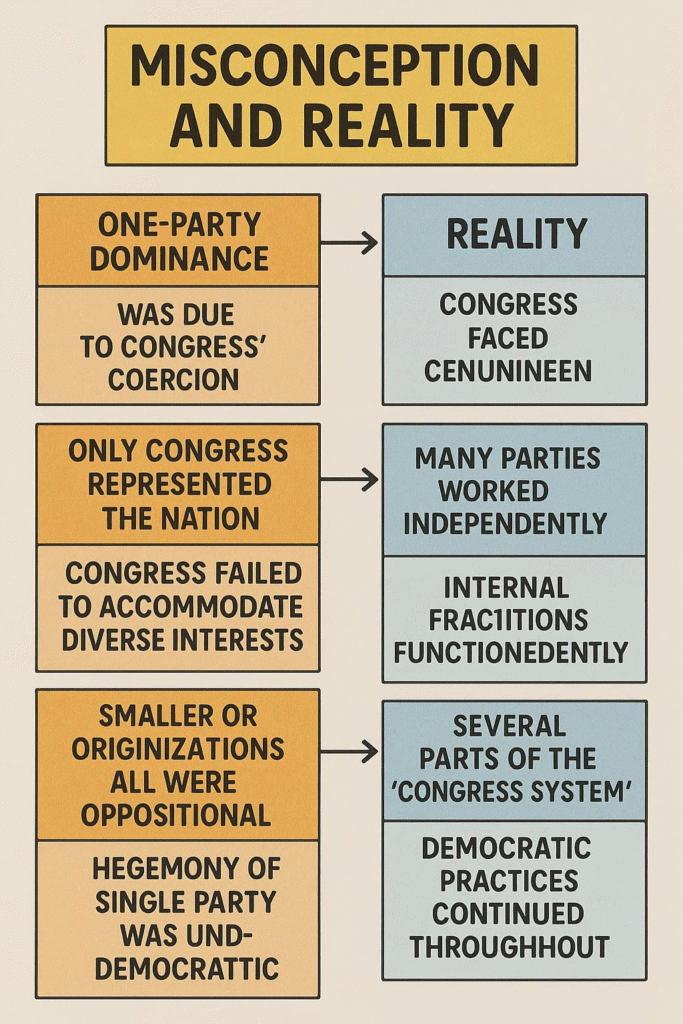
————————————————————————————————————————————————————————————————————————————
KNOWLEDGE WITH FUN
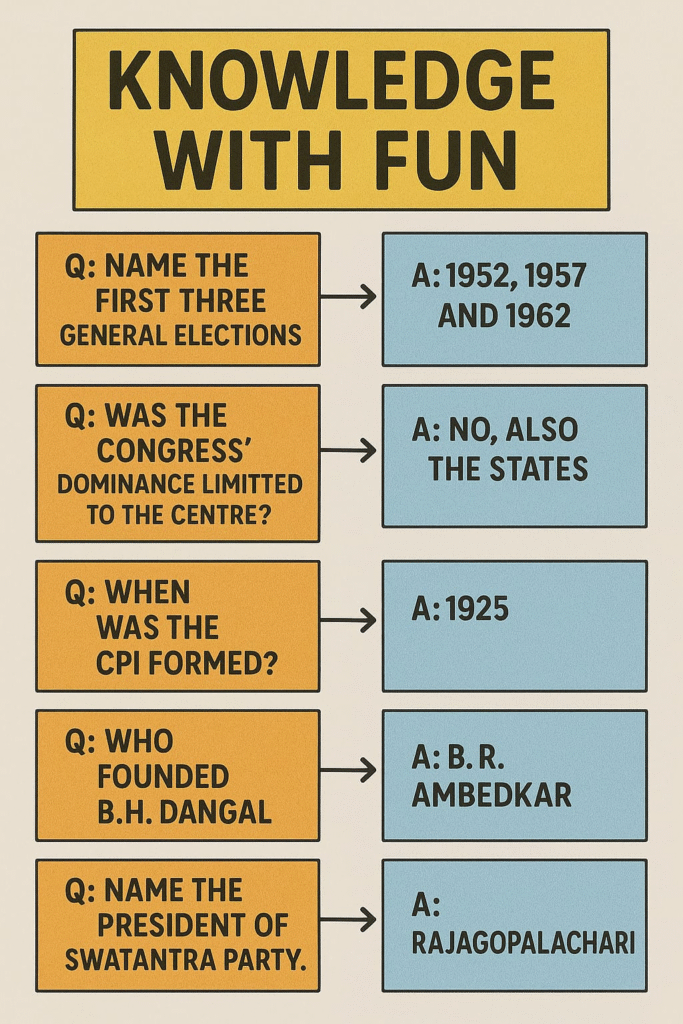
————————————————————————————————————————————————————————————————————————————
MNEMONICS
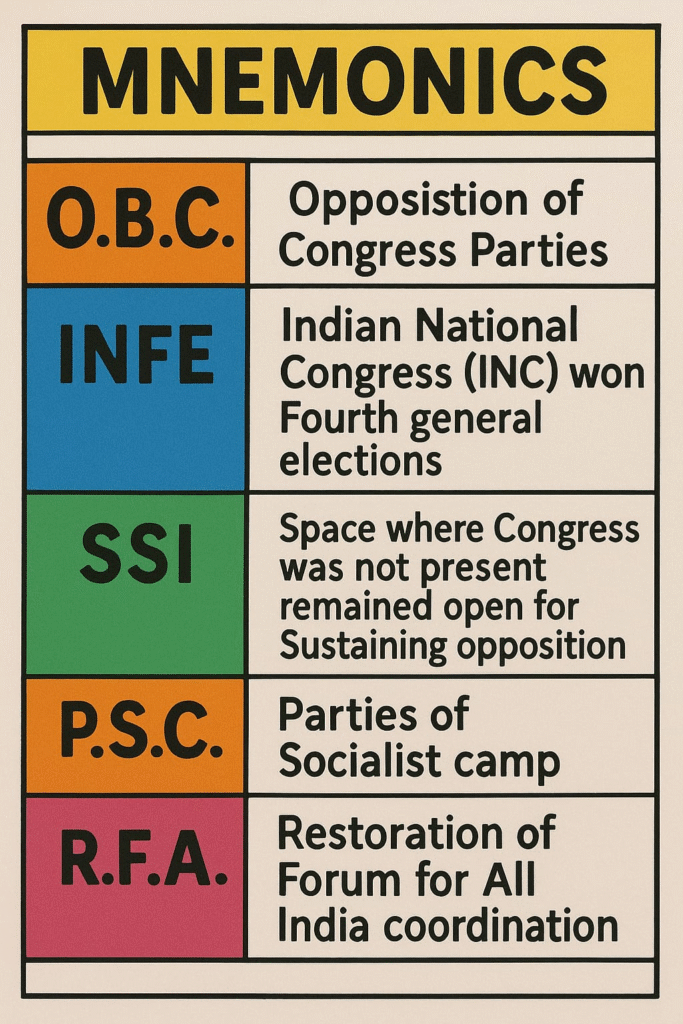
————————————————————————————————————————————————————————————————————————————
MIND MAP
